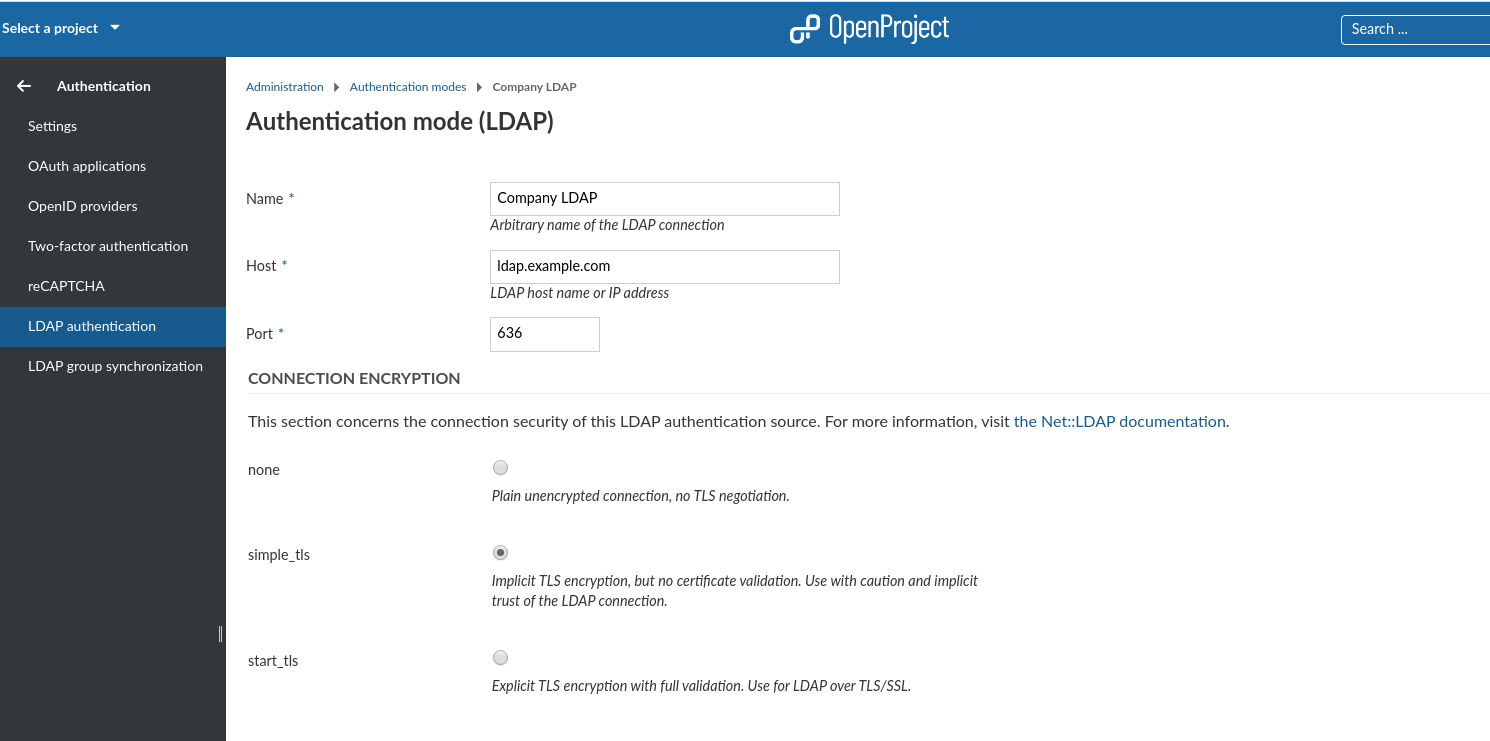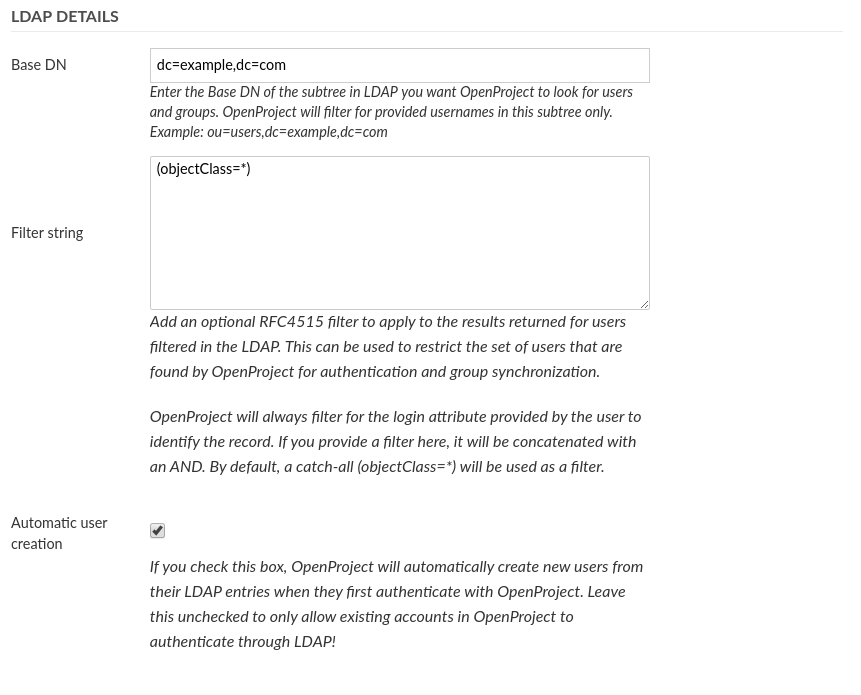|
|
4 years ago | |
|---|---|---|
| .. | ||
| ldap-group-synchronization | 4 years ago | |
| Authentication.png | ||
| README.md | 4 years ago | |
| Sys-admin_ldap-authentication.png | ||
| ldap-attribute-mapping.png | 5 years ago | |
| ldap-details.png | 5 years ago | |
| ldap-host-and-security.png | 5 years ago | |
| ldap-index-page.png | 5 years ago | |
| ldap-settings.png | 5 years ago | |
| ldap-system-user.png | 5 years ago | |
README.md
| sidebar_navigation | description | robots | keywords |
|---|---|---|---|
| [{title LDAP authentication} {priority <nil>}] | Manage LDAP Authentication in OpenProject. | index, follow | ldap authentication |
Manage LDAP Authentication
To see the list of all available LDAP (Lightweight Directory Access Protocol) authentications navigate to - > Administration and select -> Authentication -> LDAP Authentication from the menu on the left. You will see the list of all available authentications already created.
Add a new LDAP authentication
To create a new LDAP authentication click on the respective icon.
You will then be able to specify the LDAP configuration. This can be any directory service compatible with the LDAPv3 standard, such as Microsoft Active Directory or openLDAP. The configuration depends on the specific database/applications, through which the authentication with OpenProject is intended.
The following screenshots contain an exemplary configuration for a new LDAP authentication mode. In the following, we will go through all available options.
LDAP connection details and security
In the upper section, you have to specify the connection details of your LDAP server as well as the connection encryption to use.
- Name: Arbitrary identifier used to show which authentication source a user is coming from (e.g., in the Administration > Users view)
- Host: Full hostname to the LDAP server
- Port : LDAP port. Will usually be 389 for LDAP and StartTLS and 636 for LDAP over SSL connections.
- Connection encryption: Select the appropriate connection encryption.
- For unencrypted connections, select
none. No TLS/SSL connection will be established, your connection will be unsecure - For LDAPS connections (LDAP over SSL), use
simple_tls, this is an older SSL encryption pattern that uses SSL certificates, but DOES NOT VERIFY THEM. Implicit trust in the connection will be placed, but the connection will be encrypted. Some older LDAP servers only support this option - Recommended option:
start_tlswill use TLS to encrypt the connection after connecting to the LDAP server on the unencrypted PORT (389by default). - Click here to read more details into what these options mean for connection security.
- For unencrypted connections, select
Allowing untrusted certifcates for LDAP connections
If you use start_tls , certificate details and host names will be verified on connections as recommended for security. In case you use a custom untrusted certificate authority (CA) that your LDAP is connecting to, you can place this CA in your system's trusted CA store if possible. For some distributions, you will need to specify this CA manually to OpenProject.
You can do this by using the advanced configuration function of OpenProject. You can define the CA path by setting the following ENV variable:
OPENPROJECT_LDAP__TLS__OPTIONS_CA__FILE="/path/to/the/root-ca.crt"
or by extending your production configuration of config/configuration.yml with the following segment:
production:
# .. other settings ..
# ldap_tls_options:
# ca_file: "/path/to/the/root-ca.crt"
You can set other TLS options for the LDAP auth source connection. They are passed as the tls_options to the Net::LDAP gem and ultimately end up in the SSLContext setting of Ruby. You can define the TLS version and other advanced options in case your connections needs it. Most users will not need to change this however.
See the following resources for more information:
- https://github.com/ruby-ldap/ruby-net-ldap/blob/master/lib/net/ldap.rb
- https://ruby.github.io/openssl/OpenSSL/SSL/SSLContext.html
LDAP system user credentials
Next, you will need to enter a system user that has READ access to the users for identification and synchronization purposes. Note that most operations to the LDAP during authentication will not be using these credentials, but the user-provided credentials in the login form in order to perform a regular user bind to the LDAP.
- Account: The full DN of a system users used for looking up user details in the LDAP. It must have read permissions under the Base DN. This will not be used for the user bind upon authentication.
- Password: The bind password of the system user’s DN above.
LDAP details
Next you can define what sections OpenProject will look for in the LDAP and also if users should be created automatically in OpenProject when they are accessing it. Let's look at the available options:
- Base DN: Enter the Base DN to search within for users and groups in the LDAP tree
- Filter string: Enter an optional LDAP RFC4515 filter string to further reduce the returned set of users. This allows you to restrict access to OpenProject with a very flexible filter. For group synchronization, only users matching this filter will be added as well.
- Automatic user creation: Check to automatically create users in OpenProject when they first login in OpenProject. It will use the LDAP attribute mapping below to fill out required attributes. The user will be forwarded to a registration screen to complete required attributes if they are missing in the LDAP.
Attribute mapping
The attribute mapping is used to identify attributes of OpenProject with attributes of the LDAP directory. At least the login attribute is required to create DNs from the login credentials.
- Login: The login attribute in the ldap. Will be used to construct the DN from
login-attribute=value,. Most often, this will be uid. - First name: The attribute name in the LDAP that maps to first name. Most often, this will be givenName. If left empty, user will be prompted to enter upon registration if automatic user creation is true.
- Last name: The attribute name in the LDAP that maps to last name. Most often, this will be sn. If left empty, user will be prompted to enter upon registration if automatic user creation is true.
- Email: The attribute name in the LDAP that maps to the user’s mail address. This will usually be mail. If left empty, user will be prompted to enter upon registration if automatic user creation is true.
- Admin: Specify an attribute that if it has a truthy value, results in the user in OpenProject becoming an admin account. Leave empty to never set admin status from LDAP attributes.
Lastly, click on Create to save the LDAP authentication mode. You will be redirected to the index page with the created authentication mode. Click the test button to create a test connection using the system user’s bind credentials.
With the OpenProject Enterprise Edition it is possible to synchronize LDAP and OpenProject groups.
Multiple LDAP connections
OpenProject supports multiple LDAP connections to source users from. The user's authentication source is remembered the first time it is created (but can be switched in the administration backend). This ensures that the correct connection / LDAP source will be used for the user.
Duplicates in the unique attributes (login, email) are not allowed and a second user with the same attributes will not be able to login. Please ensure that amongst all LDAP connections, a unique attribute is used that does not result in conflicting logins.





